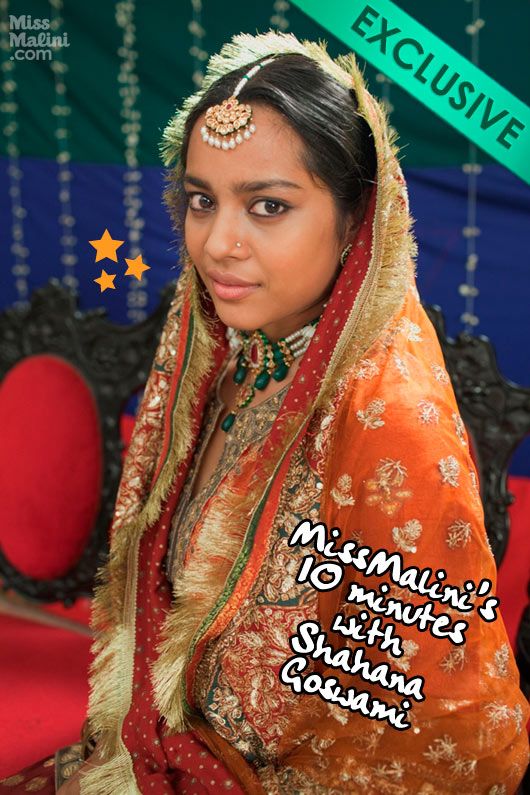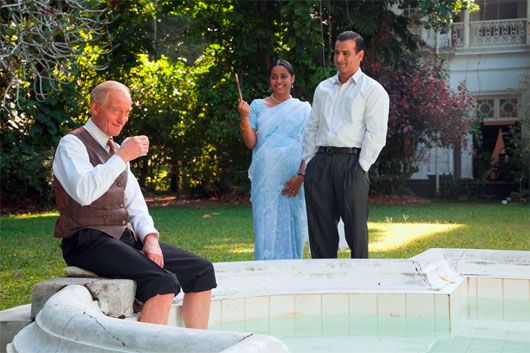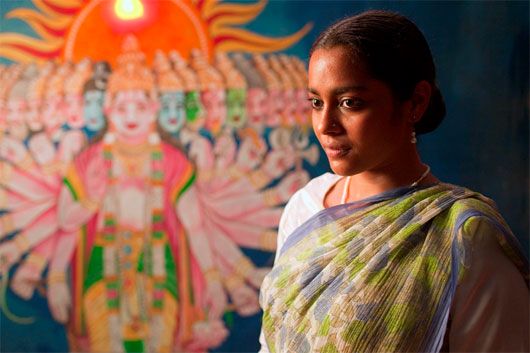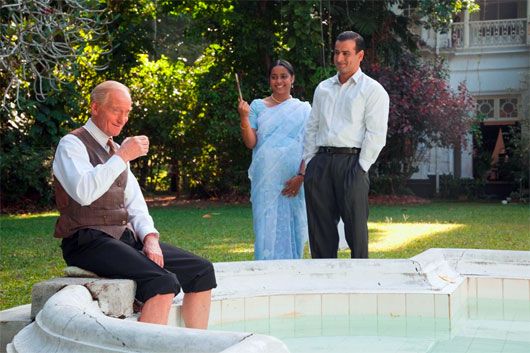
I’ve always liked Shahana Goswami. Ever since Rock On and the passion with which she performed in Rohan Sippy‘s first broadway-style musical. So I am intrigued to see her now in Deepa Mehta’s adaptation of Salman Rushdie‘s epic novel Midnight’s Children. I caught up with her on the phone before it releases this Friday, Febuary 01, 2013. Listen in below!
Shahana Goswami on Midnight’s Children, the book v/s the movie and getting the part!
MissMalini: Hi Shahana, how are you?
Shahana Goswami: Hi Malini, how are you? I’m good.
MM: Thanks so much for chatting with us and we’re excited to see Midnight’s Children. Tell us a little about the movie.
SG: I always say this to people, especially those who have read the book – it’s always difficult to adapt a book into a film. They are two different mediums, especially a book like Midnight’s Children that has such an elaborate narrative. This is one perspective, I’d say, on the book. I don’t think a book like this could be encapsulated exactly as written; this is one perspective on the book – well, an agreed perspective between the writer and director. The combination of Salman writing the screenplay and Deepa shooting it and giving the creative vision to it made it a really beautiful take on the book.
MM: Did you read the book? What did you think of it?
SG: Strangely, I didn’t read it while growing up, but I did read it before I was meant to meet them. I wanted to know the narrative before I went to meet them. My meeting was fixed for a few days later, and I knew I had just three days to read the book and I’m a very slow reader. But I started reading it and the style of writing clicked with me in terms of what I like. I managed to go through 300 pages before I met them. I completed the rest later. I really loved the narrative, that’s why I managed to go through 300 pages so quickly. Funnily enough, I kept imaging myself playing the character I was eventually offered, so I was really thrilled. I remember when I was told that Deepa wanted me to play Amina, I was literally jumping and waving my arms like a lunatic while trying to sound calm and saying, “Oh that’s lovely, sure, of course, why would I not want to?” So for me it was a perfect journey being introduced to this beautiful, epic book, and straightway meeting the writer of the book and a very prestigious director. I couldn’t have asked for something better.
Shahana Goswami on ageing through the film.
MM: You actually play a character who ages quite a bit; you go from 19-45 in the film. Did you age or did you go back and forth?
SG: No we did actually go back in forth a little bit. Deepa did make sure that we started with the younger bits, but there were places where, because of location and practicality, you do have to move back and forth. We did the groundwork with Deepa’s guidance, so it wasn’t so difficult. Initially we had workshops, and those workshops really helped in finding the essence of the character. I mean, it’s also a book that has a lot of interconnected relationships, some very obvious ones and some not-so-obvious ones. For example, the fact that babies are swapped – the one I think is my son is not, and the one I don’t meet ends up being my son. So there are so many people and so many complicated relationships with them, so all those things were established through workshops and detailed discussions about each scene with the actors. She would take each actor and do all their scenes with all the other characters through readings. Beside that, on the day of the shoot, she would rehearse each scene as many number of times as there were actors in the scene, each time focusing on only one particular actor and their motivation for their character, however big or small their contribution was to that scene.

SG: Honestly, we just had to go with the flow of it to bring out the best. Deepa really has a gift with actors in terms of how she brings things out. Very good emotional understanding, and she was very focused with her work – I don’t think she thought about anything but that book and the film 24/7 for those months she was shooting. The aging part actually was very easy I would say; just getting into a different costume or a slight change in hair or makeup. Deepa was very clear she didn’t want prosthetic make up, so what was done was just a slight of highlighting of lines on your face, or allowing your dark circles to show. But there were other things in terms of using the period, using the age-specific understanding in things like costume and hair. Little things like when I’m younger, I have a plain, oiled plait and my clothes are salwaar-kameezes. When I get married, and I’m pregnant, I still have my braid but I start wearing cotton saris. Then once I have a ten-year-old, there’s a certain maturity, so the hair changes to a bun and the clothes become a pinned-up chiffon sari. So little things like this would help bring out that feeling. I remember the first day we did that scene and we were playing the oldest bracket, all of us had a certain fatigue and languidness as soon as we were put into hair, makeup and costume just seeing ourselves look like that. So many of these things are visually aiding.
Shahana Goswami on her love making scene in Midnight’s Children and being pegged an non-commercial actress.

MM: The first scene you shot was a lovemaking scene, is that kind of scary? What was it like without your cofactor?
SG: Well you know, everybody is always very sensitive and considerate when it comes to these scenes. My approach has always been to see it as any other scene. When you take away the taboo from it, it’s just as difficult or stressful as doing a very emotional scene. When I have to do scenes where I have to breakdown, I get very tense or nervous. The only thing I keep telling myself is not to think of it, and lose inhibition and forget that there’s a camera or people watching. One of my tricks is to tell myself is that it’s as uncomfortable as unusual as it would to play any other scene. For me, the minute I am doing this scene, I am completely uninhibited. I could be naked also and it wouldn’t make a difference for me, because I don’t think about it. I remember, for example, in this scene what was unusual was Zaib Shaikh, who I have my lovemaking scene with, is a Canadian-Indian actor and he had just flown down to Sri Lanka. This was one of the first few scenes. So unfortunately I didn’t have enough time to get comfortable with him; that was only the thing that was making our nervous. But we did a blocking of the scene, and in the blocking I had to take off my kurta. I was just in a bra and all I told myself is “Hey come on, we’re all comfortable wearing bkinis on the beach and it’s the same thing.” Then it wasn’t such a problem. Honestly when I’ve kissed people on screen, even though you put yourself into it, you’re aware you’re doing it for a part. If you ask me, I can’t tell you what it felt like because my mind was too preoccupied subconsciously that this was a performance. So if you ask me was he a good kisser, I wouldn’t be able to tell you because I don’t have any memory in terms of the sensual feeling.
MM: So we have some Twitter questions for you. “Do you consider yourself a more commercial actress or more parallel or do you not choose?”
SG: Well, my answer would be that I consider myself to be an actor that can do everything. But what I feel has been projected so far is that I am alternative actor. My aim has always been to break out of that. Sometimes I do feel stuck, I feel like nobody can imagine me playing anything else, whereas my natural instinct is to be so many different people. I’ve learned dance, I’ve been a sportsman, I love swimming, I’m very tomboyish, I’ve done a musical, I’ve always been considered a clown because of the way I make people laugh – but I’ve not gone a chance to show these parts. The depiction is that I’m serious, so all the roles I’ve done have been slightly more mature.
Shahana Goswami on Bollywood, Kareena Kapoor and her BFF Deepika Padukone!
MM: Everyone wants to know about your experience working with other stars like Kareena, and I believe you and Deepika are really good friends… so can you tell us a little about your experiences with them?
SG: Ya, actually, anybody coming from outside the film world has this anxiety that it’s a world you won’t fit into and people are a certain way. I’ve had a touchwood very smooth journey of meeting interesting, lovely people. I’m realizing that at the end of the day they are normal human beings and they’re just in a profession that is more out there and under scrutiny. But it doesn’t make you, as a person, any different from anybody in a corporate world, perhaps. I myself am a very real person, and find it difficult to be someone else. I always get caught if I try to lie – that whole pretense I can’t do, and I’ve found enough in the industry who are like that. I’ve gotten a lot acceptance and warmth from people I have looked up to in my life. Even someone like Deepika, I remember when I saw her in Om Shanti Om I thought she was so beautiful and I was really inspired by her. But then I met her on Break Ke Baad and she was the most down-to-earth and rooted person, most normal person I could meet. Similarity for other people – even Soha, who I met on Midnight’s Children, we got along really well. I met Imran on Break Ek Baad, we’re all people who are very much in touch. Even a person like Shah Rukh or Kareena, or Abhishek/Aishwarya, whenever I meet them, I feel a lot of warmth from then. People really want to be normal and real. In some ways it’s just that there’s a certain barrier between you and your fans who are watching you with these awe-struck eyes, but at the end of the day everyone wants to have normal equations with people.

MM: Any movie that went by recently that you were like “damn, I wish I had done that?”
SG: So many. The last year that went by has had some fabulous films. This year it would be a really tough choice in choosing who was the best film, best actor – there were so many great products. I wish I was in Barfi, Kahaani, Ishaqzaade, Ek Main Aur Ek Tu, Gangs of Wasseypur… to me, all these films were very exciting, and my envy is a very positive envy, because it makes me feel if there’s such great work happing right now, we’ll only grow and there will be more opportunities for everyone to be part of something that is great quality cinema.
MM: Absolutely. We’re very exciting for Midnight’s Children, and now we can’t wait to see you in a masala Bollywood film. Any message for your MissMalini fans who are listening right now?
SG: Just that please go watch the film and give your honest feedback. And pray that I get all the different kind of roles that I want to do and have something to come back and show to you that you can be proud of.
Midnight’s Children – The Book
Midnight’s Children is a 1980 book by Salman Rushdie that deals with India’s transition from British colonialism to independence and the partition of British India. It is considered an example of postcolonial literature and magical realism. The story is told by its chief protagonist, Saleem Sinai, and is set in the context of actual historical events as with historical fiction.
The book begins with the story of the Sinai family, particularly with events leading up to India’s Independence and Partition. Saleem is born precisely at midnight, August 15, 1947, and is, therefore, exactly as old as the independent republic of India. He later discovers that all children born in India between 12am and 1am on that date are imbued with special powers. Saleem, using his telepathic powers, assembles a Midnight Children’s Conference, reflective of the issues India faced in its early statehood concerning the cultural, linguistic, religious, and political differences faced by a vastly diverse nation. Saleem acts as a telepathic conduit, bringing hundreds of geographically disparate children into contact while also attempting to discover the meaning of their gifts. In particular, those children born closest to the stroke of midnight wield more powerful gifts than the others. Shiva “of the Knees”, Saleem’s nemesis, and Parvati, called “Parvati-the-witch,” are two of these children with notable gifts and roles in Saleem’s story.

